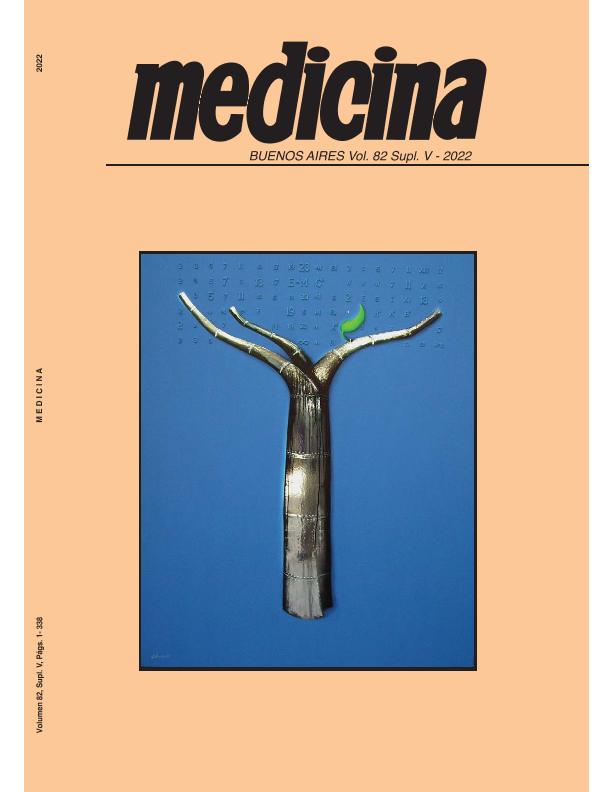Evento
2-arachidonoylglycerol metabolism is modulated by cannabinoid receptor ligands and by phototransduction related proteins in retinal rod outer segments
Chamorro Aguirre, Estefania ; Gaveglio, Virginia Lucía
; Gaveglio, Virginia Lucía ; Pascual, Ana Clara
; Pascual, Ana Clara ; Pasquaré, Susana Juana
; Pasquaré, Susana Juana
 ; Gaveglio, Virginia Lucía
; Gaveglio, Virginia Lucía ; Pascual, Ana Clara
; Pascual, Ana Clara ; Pasquaré, Susana Juana
; Pasquaré, Susana Juana
Tipo del evento:
Reunión
Nombre del evento:
LXVII Reunión Anual de la Sociedad Argentina de Investigación Clínica; LXX Reunión Anual de La Sociedad Argentina de Inmunología; 3er Congreso Franco-Argentino De Inmunología y Reunión Anual 2022 de La Sociedad Argentina De Fisiología
Fecha del evento:
16/11/2022
Institución Organizadora:
Sociedad Argentina de Investigación Clínica;
Sociedad Argentina de Inmunología;
Sociedad Argentina de Fisiología;
Título de la revista:
Medicina (Buenos Aires)
Editorial:
Fundación Revista Medicina
ISSN:
0025-7680
e-ISSN:
1669-9106
Idioma:
Inglés
Clasificación temática:
Resumen
The endocannabinoid 2-arachidonoylglycerol (2-AG) level in the central nervous system is regulated mainly by diacylglycerol- and monoacylglycerol-lipase (DAGL and MAGL) activities. Lysophos- phatidate phosphohydrolase (LPAP) could also generate 2-AG from 2-arachinodonoyl lysophosphatidate. Previous studies demon- strated that MAGL activity is modified in rod outer segment (ROS) membranes treated with buffers of low (5 mM Tris-HCl) or moderate (100 mM Tris-HCl) ionic strength, which mostly extract rhodopsin kinase (RK) and arrestin (Arr), both being proteins related to the phototransduction process. One aim of this work was to analyze if cannabinoid receptor ligands WIN55212-2 (WIN), JWH-133 (JWH), SR141716 (SR1) and SR144528 (SR2) modulate these enzymatic activities in ROS isolated from dark-adapted bovine retinas and ex- posed to light (3000 lux, ROS B) or kept under darkness (ROS O) for 30 min at 37 °C. Thus, ROS O/B were incubated with cannabi- noid ligands for 10 min before adding the radiolabeled substrate. It was observed that WIN and JWH agonists (5 μM) diminished MAG production from LPA by 32% and 60% in ROS O and ROS B, re- spectively. SR1 and SR2 antagonists (1 μM) also generated a MAG diminution of 71% and 51% in ROS O, respectively, while both an- tagonists diminished it by 48% in ROS B (n=5, p<0.05). On the other hand, DAGL activity was evaluated in ROS membranes treated at 5 mM or 100 mM in dark or light (3000 lux) for 30 min using radiola- beled diacylglycerol as substrate. DAGL activity diminished by 25% and 55% at low and moderate ionic strength in ROS O, respectively. A diminution of 60% in DAGL activity under both treatments was observed in ROS B (n=4, p<0.05). This suggests that RK or Arr mod- ulate DAGL activity. Taken together, these results indicate that 2-AG metabolism is regulated by cannabinoid receptor ligands as well as by the phototransduction process, suggesting an important role of the endocannabinoid system in the visual cycle.
Palabras clave:
2-ARACHIDONOYLGLYCEROL
,
CANNABINOIDS
,
PHOTOTRANSDUCTION
,
RODS
Archivos asociados
Licencia
Identificadores
Colecciones
Eventos(INIBIBB)
Eventos de INST.DE INVEST.BIOQUIMICAS BAHIA BLANCA (I)
Eventos de INST.DE INVEST.BIOQUIMICAS BAHIA BLANCA (I)
Citación
2-arachidonoylglycerol metabolism is modulated by cannabinoid receptor ligands and by phototransduction related proteins in retinal rod outer segments; LXVII Reunión Anual de la Sociedad Argentina de Investigación Clínica; LXX Reunión Anual de La Sociedad Argentina de Inmunología; 3er Congreso Franco-Argentino De Inmunología y Reunión Anual 2022 de La Sociedad Argentina De Fisiología; Mar del Plata; Argentina; 2022; 212-212
Compartir



